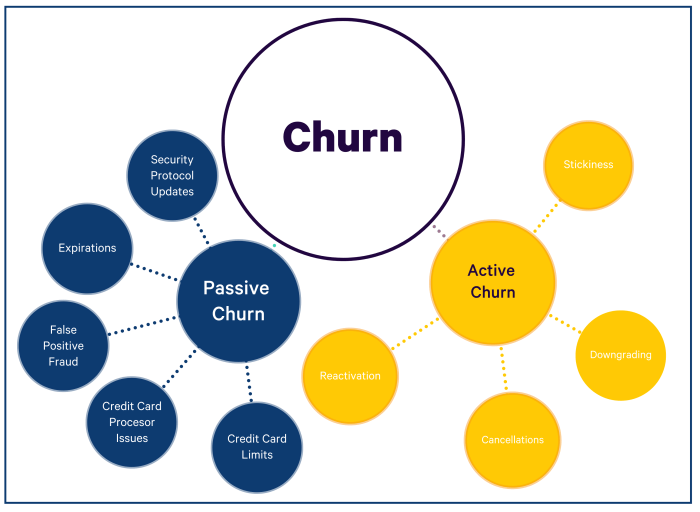Understanding Customer Churn sheds light on the critical aspects of customer retention in the business realm, offering a deep dive into the factors influencing churn rates and effective strategies for reducing them. Get ready for a rollercoaster ride of insights and solutions!
From exploring the metrics used to measure churn to delving into the world of predictive analytics, this comprehensive guide has got you covered. Let’s navigate the intricate landscape of customer churn together and emerge with a winning strategy in hand.
Introduction to Customer Churn
Customer churn refers to the rate at which customers stop doing business with a company or stop using its services. Understanding customer churn is crucial for companies as it directly impacts their revenue and profitability. By identifying the reasons why customers are leaving, businesses can take proactive measures to retain them and improve customer loyalty.
Examples of Industries with Significant Customer Churn
- In the telecommunications industry, customer churn is a major concern due to intense competition and the availability of numerous service providers. Customers often switch between providers based on pricing, service quality, and promotional offers.
- In the subscription-based business model, such as streaming services like Netflix or Spotify, customer churn is closely monitored as it affects their recurring revenue stream. Companies in this industry focus on providing engaging content and personalized recommendations to reduce churn rates.
- Retail businesses also face customer churn challenges, especially with the rise of e-commerce platforms. Factors such as product availability, pricing, and customer service play a crucial role in retaining customers and preventing them from switching to competitors.
Factors Influencing Customer Churn

Customer churn can be influenced by various factors that impact a business’s ability to retain customers. Understanding these factors is crucial for implementing strategies to reduce churn rates and improve customer loyalty.Customer satisfaction is a key factor that plays a significant role in determining churn rates. Satisfied customers are more likely to remain loyal to a brand and continue using its products or services.
On the other hand, dissatisfied customers are at a higher risk of churning, especially if their issues are not addressed promptly and effectively.The impact of pricing on customer churn is undeniable. Customers are constantly evaluating the value they receive in exchange for the price they pay. If a competitor offers a similar product or service at a lower price, customers may be tempted to switch providers, leading to churn.
It is essential for businesses to find the right balance between pricing and perceived value to retain customers.Competition in the market also plays a significant role in influencing customer churn. With numerous options available to consumers, businesses must differentiate themselves from competitors to retain customers. Providing exceptional customer service, personalized experiences, and unique offerings can help businesses stand out in a crowded market and reduce churn rates.
Impact of Customer Service on Churn
Customer service is a critical factor that can either increase or decrease customer churn rates. Businesses that prioritize customer satisfaction and provide excellent customer service are more likely to retain customers. On the other hand, poor customer service can lead to dissatisfaction and ultimately result in customer churn. Responding to customer queries promptly, resolving issues efficiently, and going the extra mile to meet customer needs can help businesses build strong relationships with customers and reduce churn rates.
Measuring Customer Churn
Customer churn is a critical metric for businesses to monitor as it directly impacts revenue and growth. By understanding and measuring customer churn, companies can identify areas for improvement and develop strategies to retain customers.
Common Metrics Used to Measure Customer Churn
When measuring customer churn, businesses often utilize the following key metrics:
- Churn Rate: The percentage of customers who have canceled their subscription or stopped using a service within a specific time period.
- Retention Rate: The percentage of customers who continue to use a service over a given period.
- Net Promoter Score (NPS): A metric that measures customer loyalty and likelihood to recommend a company to others.
- Customer Lifetime Value (CLV): The total revenue a business can expect from a customer throughout their relationship.
Importance of Tracking Customer Churn Over Time
Tracking customer churn over time provides valuable insights into the health of a business and the effectiveness of customer retention efforts. By monitoring churn rates and trends, companies can proactively address issues, improve customer satisfaction, and increase overall revenue.
Calculating Customer Churn Rate and Its Significance
Customer churn rate is calculated by dividing the number of customers lost during a specific period by the total number of customers at the beginning of that period. The formula is:
Churn Rate = (Customers Lost / Total Customers) x 100
Understanding the customer churn rate is crucial for businesses to identify reasons for customer attrition and take necessary actions to reduce churn. A high churn rate can indicate dissatisfaction with products or services, poor customer service, or increased competition in the market. By measuring and analyzing churn rate, companies can implement strategies to improve customer retention and drive long-term growth.
Strategies to Reduce Customer Churn: Understanding Customer Churn

Reducing customer churn is crucial for the long-term success of any business. By implementing proactive strategies, companies can effectively retain customers and build loyalty.
The Role of Customer Engagement and Loyalty Programs
Customer engagement plays a vital role in reducing churn as it involves interacting with customers to create a positive relationship. By keeping customers engaged through personalized communication, special offers, and excellent customer service, businesses can increase customer satisfaction and loyalty. Loyalty programs also play a significant role in churn prevention by rewarding customers for their repeat business, creating incentives for them to stay with the company.
Examples of Successful Customer Retention Strategies
- Personalized Communication: Sending personalized emails, messages, or offers based on customer preferences and behavior can make customers feel valued and appreciated.
- Excellent Customer Service: Providing exceptional customer service can turn a dissatisfied customer into a loyal one. Resolving issues promptly and efficiently can help retain customers.
- Reward Programs: Implementing reward programs that offer discounts, freebies, or exclusive deals to loyal customers can incentivize them to continue doing business with the company.
- Feedback Mechanisms: Actively seeking feedback from customers and acting upon it can show customers that their opinions matter, leading to increased loyalty and satisfaction.
Technologies for Predicting Customer Churn
Predicting customer churn is crucial for businesses to retain their customer base and maximize profitability. Leveraging advanced technologies such as AI and machine learning can greatly enhance the accuracy and efficiency of predicting customer churn. These technologies enable companies to analyze vast amounts of customer data to identify patterns and trends that indicate potential churn.
AI and Machine Learning in Predicting Customer Churn
AI and machine learning algorithms have the capability to process large datasets and extract valuable insights that may not be apparent through traditional methods. By utilizing these technologies, businesses can create predictive models that forecast the likelihood of a customer churning based on various factors such as past behavior, interactions, and demographics. This proactive approach allows companies to take timely actions to prevent churn and retain valuable customers.
Data Analytics for Early Churn Detection
Data analytics plays a crucial role in identifying early signs of potential churn. By analyzing customer behavior and engagement metrics, businesses can pinpoint customers who are showing signs of disengagement or dissatisfaction. This early detection enables companies to intervene with targeted retention strategies before customers decide to churn, ultimately improving customer retention rates.
Benefits of Predictive Modeling in Reducing Churn, Understanding Customer Churn
Predictive modeling offers several benefits in reducing customer churn. By accurately predicting which customers are at risk of churning, businesses can implement personalized retention strategies to address their specific needs and concerns. This targeted approach increases the likelihood of retaining customers and fostering long-term loyalty. Additionally, predictive modeling allows companies to optimize resource allocation by focusing efforts on high-risk customers, ultimately leading to cost savings and improved customer satisfaction.
